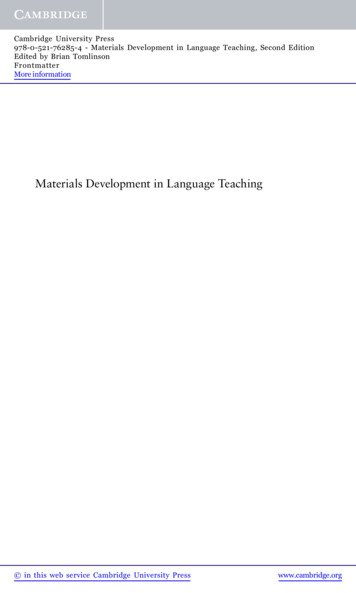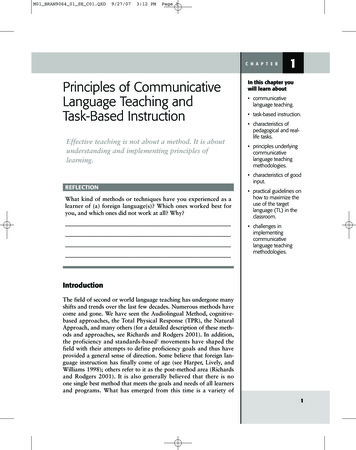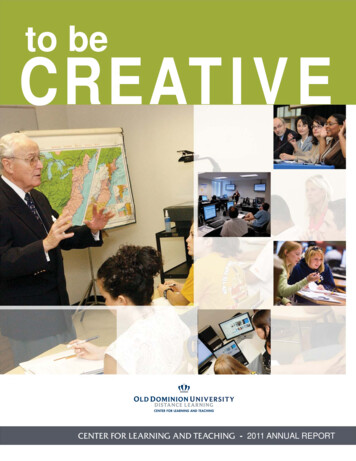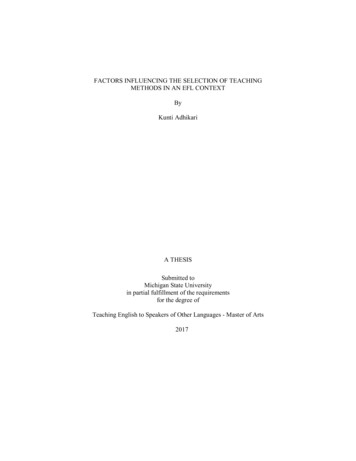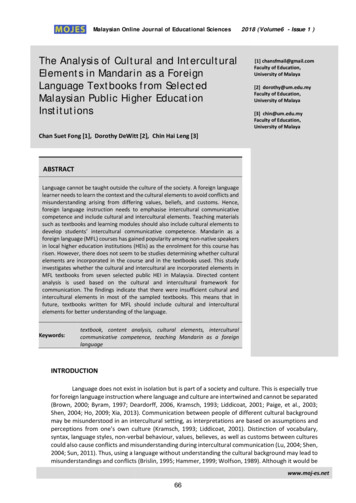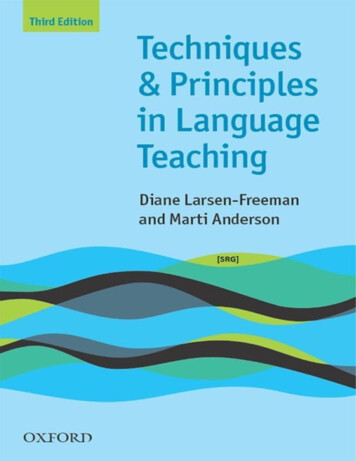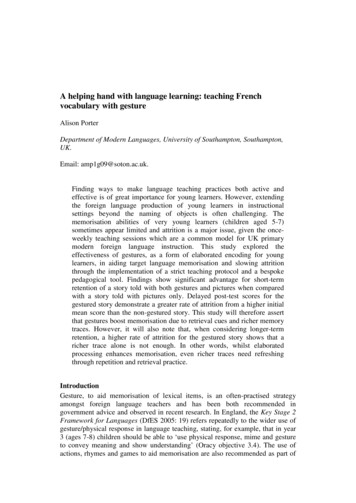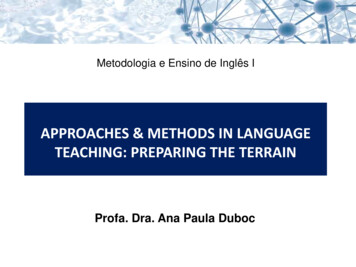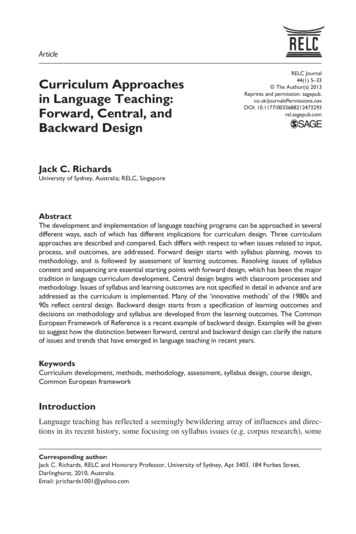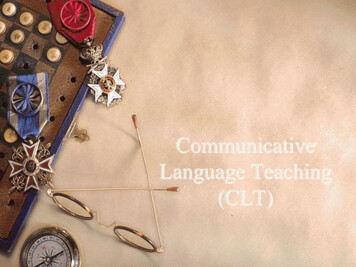
Transcription
CommunicativeLanguage Teaching(CLT)
Communicative Language Teaching (A functional approach since 1970s):it is an approach, not a method; a unified butbroadly based theoretical position about thenature of language and of language learningand teaching.
Background This approach is found in the changes in theBritish language teaching tradition dating from thelate 1960s. A lot of British linguists contributed tothe formation of the Communicative Approachwhich aims to make communicative competence(Hymes, 1972) the goal of language teaching anddevelop procedures for the teaching of the fourlanguage skills that acknowledge theinterdependence of language and communication.Communicative competence is what a speakerneeds to know in order to be communicativelycompetent in a speech community.
BackgroundRichards and Rodgers (1986) describedCLT as an approach rather than a method,since it represents a philosophy of teachingthat is based on communicative lg use.Advocated by many applied linguists, CLTin their views emphasizes notionalfunctional concepts and communicativecompetence, rather than grammaticalstructures, as central to teaching.
Background The major characteristics are:Meaning is primary; contextualization is basic.Attempts to communicate in TL are encouraged in thebeginning of instruction.Material sequencing is determined by the content,meaning, and function.L1 is acceptable when feasible.Activities and strategies for learning are varied.Communicative competence is the goal of instruction.
Theory of LanguageHymesa person who acquires communicative competenceacquires both knowledge and ability for language usewith respect to the following: whether something is formally possible; whether something is feasible in virtue of the means ofimplementation available; whether something is appropriate in relation to acontext in which it is used and evaluated; whether something is in fact done, actually performedand what its doing entails
Canale and Swainidentified four dimensions of communicative competence:Grammatical competence- similar to linguisticcompetence by Chomsky by what is formallypossibleSociolinguistic competence- understanding of the socialcontext in which communication takes place,including role relationships, the shared informationof the participants, and the purpose for theirinteractionDiscourse competence- the interpretation of individualmessage elements in terms of cohesion andcoherenceStrategic competence- the coping strategies to initiate,terminate, maintain, repair, and redirectcommunication
HallidayFunctional theoryBasic functions of language: Instrumental Regulatory Interactional Personal Heuristic Imaginative Representational
WiddowsonThe relationship between linguistic systemsand their communicative values in text anddiscourse
Theory of learningThree principles communication, task, meaningfulness the communication principle: Activities thatinvolve communication promote lg learning. the task principle: Activities that involve thecompletion of real-world tasks promotelearning. the meaningfulness principle: Learners must beengaged in meaningful and authentic languageuse for learning to take place.
Theory of learning Creative construction hypothesis Interactional theory Sociocultural learning theory
Objectives To communicate in the target language in authentic situations .To achieve this goal , students need to know:1-Linguistic forms2-Meanings3-Functions To acquire knowledge of the TL system To acquire knowledge of rules of speaking in the TL To use and respond to different types of speech acts To use language appropriately
What is the role of the teacher?A facilitator :facilitates communication inthe classroom and establishes situationslikely to promote communication.An advisor in the activities ,answeringstudents’ questions and monitoring theirperformance.A co-communicator, engaging in theactivities with the students.
What is the role of students? Communicators : they are actively engaged 1-In negotiatingmeaning. 2-In trying to make themselves understood and 3-In understanding others More responsible managers of their own ent learner
What are some characteristics ofthe teaching / learning process?1-Students use the language a great dealthrough communicative activities such asgames , role plays, and problem-solvingtasks.2- The use of authentic materials.3- Activities are carried out by students insmall groups
The features of communicativeactivities1-Information gap: one person knowssomething , the other one does not.2- Choice: the speaker has a choice of what tosay and how to say it. Think about the chaindrill?3- Feedback: the purpose is achieved basedupon the information that is received fromthe listener. Think about the transformationdrill?
What is the nature of studentteacher interaction/studentstudent interaction?Students interact a great deal with oneanother, in pairs, triads, small groups andwhole group.mostly student- student interaction
How are the feelings of thestudents dealt with ?Students will be more motivated to study aforeign language since they will feel theyare learning to do something useful with thelanguage.They are given an opportunity to express theirindividuality by having them share theirideas and opinions on a regular basis.
How is the language viewed? How isthe culture viewed?*Language is for communication*Communicative competence consists of1-Linguistic competence2-Knowledge of functionsStudents have to know forms, meanings, functions , thesocial situation and the role of the interlocutor in orderto convey the intended meaning appropriately.Culture :It is everyday lifestyle of people who use the languageCertain aspects of it that are important to communication:theuse of nonverbal behavior.
What areas of language are emphasized?What language skills are emphasized?* Language functions might be emphasizedover forms.* Students work with language at thesuprasentential or discourse level. Theylearn about cohesion and coherence.* Students work with all four skills from thebeginning: oral communication, reading thearticle, listening , writing .
What is the role of the students’native language*sensible and careful use of students’ nativelanguage is permitted in CLT.*The target language should be used notonly during communicative activities, butalso for explaining the activities to thestudents or in assigning homework.
How is evaluation accomplished?The teacher evaluates not only the students’accuracy, but also their fluency.Use an integrative test which has a realcommunicative function.To assess students’ writing skill, a teachermight ask them to write a letter to a friend.
How does the teacher respond tostudent errors?Errors of form are tolerated during fluency –based activities & are seen as a naturaloutcome of the development ofcommunication skills.
The techniquesAuthentic materialse.x:a recent newspaper article.assign the homework to listen to a live radioor television broadcast.**Realia , menus ,timetables.
Scrambled sentences-Students are asked to unscramble thesentences so that the sentences are storedto their original order, learning coherenceandcohesive.-To unscramble the lines of a mixed-updialogue.-To put pictures of a picture strip story inorder and write lines to accompany the
Language gamesGames are used frequently in CLT.
Pictures strip storyPrediction of the next picturesAn example of using a problem solving taskas a communicative technique.
Role playIt gives students an opportunity to practice communicating in different social contextsand in different social roles.
Communicative Language Teaching (A functional approach since 1970s): it is an approach, not a method; a unified but broadly based theoretical position about the nature of language and of
